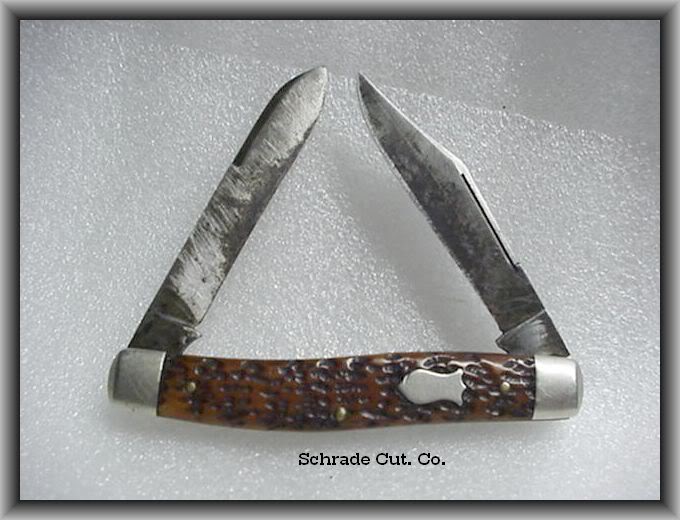ironmage wrote:It seem to be the standard 440A I find it takes a edge well and seems to hold it.The blade finish is not as nice as some it has that satin look.My biggest concern with thees China knives is how well are they tempered.So fare it seems to be a very well made knife.So I will say again"It is made as well as any Schrade has made in the last 40 years"As fare as steel is concerned today's steel are fare Superior win compared to any up to this point in time and that is just a fact.
I managed to borrow one; I could play with it as long as I returned it sharp. As found it was lightly used, with what was left of the factory edge. Fit and finish of the metal seemed about par for late Schrade production, but not as nicely done as in the '80s. As Ironmage wrote, the blades had sort of a "satin" finish, not buffed to a high finish--but a very even finish. Not a bad looking knife, and clearly inspired by one of my all-time favorite patterns (Schrade 294).
Scales were fit OK but there were traces of some substance around the edges (maybe glue or something similar). I'm not sure what that means, I don't know if they are gluing handles before pinning or maybe using some sort of glue-like bedding compound. It could have been some sort of buffing compound, but it seemed more like a layer under the scales, which would argue against that. But who knows--since I had to return the knife, I couldn't take it apart. Gaps were noted around the shield. Jigging of the bone was fairly even--not perfect, not bad (no one seems to do it "perfect" these days). In hand it felt a bit "blocky" compared to my old 194OT, not quite as smooth as a 294, but there weren't any sharp edges or corners.
Blades: since I had to return it, I couldn't snap a blade and look at it under magnification to see the carbides and grain structure to compare with old Schrade production. The guy who tested hardness for me said it came out at RC 53. Per information that has come out since the demise of Schrade in Ellenville, Schrade's target for hardness for "440 SS" was RC 56-58; for "410-51 SS" the target was 48-50. The only comparable Schrade+ blade I can recall having had tested was an End of Days 194OT (stainless but not marked "Schrade+") that went 56 RC. Schrade's target hardness for 1095 (non-stainless) blades was RC 56-58; the results I've read indicate they were very consistent with this.
I compared the Taylor Schrade with 2 similar knives (the stainless 194OT and a standard 194OT). All three blades were sharpened to the same angles (included angles of 30 degrees and 40 degrees). I did a variety of tasks that I use my pocketknives for, ranging from slicing vegetables and fruit to carving wood/bone/horn. The Taylor Schrade did well on the vegetables but so did the other knives. On hard materials (particularly horn and bone), the Taylor Schrade didn't hold an edge as long as the others. The blade was soft enough I noticed some slight deflection of the edge a couple times. On a diamond stone, the new knife felt just ever-so-slightly "gummy": not like a SAK, but a bit moreso than the stainless 194OT.
In general, based on one example--compared to both an '80s vintage 194OT (non-stainless) and an End of Days 194OT (stainless) made at the absolute low point of Ellenville production--I can't agree this example was "made as good as anything Schrade has made in 40 years." That isn't saying it is a bad knife, just that it is not the same.
As for the OP's claim that "today's steel are fare Superior win compared to any up to this point in time and that is just a fact," that may or may not be true. It depends on how you compare the steels, and exactly which steels you are comparing. For example, it has been suggested that some of the factories producing knives in China may be substituting a similar but not identical steel without notification to customers; Ellenville Schrade seems to have done something similar. If you want to compare 1955-production of 1095 with 1095 today, analyzed in the same lab at the same time, or machined and heat-treated in the same way, you could maybe say something with a degree of certainty.
